BS107A
ABClonal Rat IL-1 beta ELISA Kit RK00009说明书
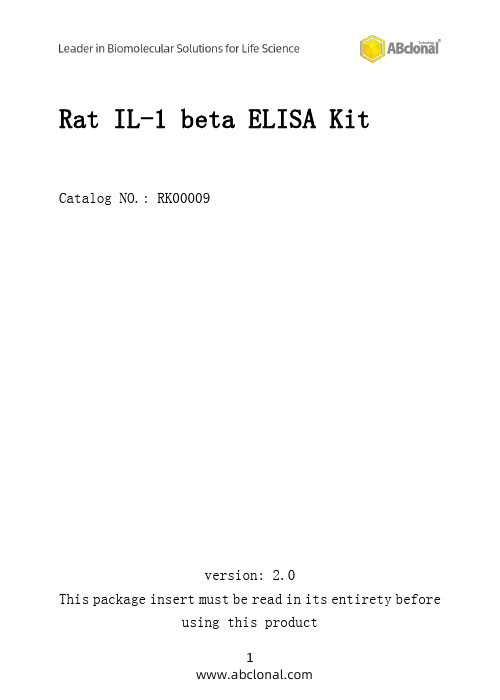
Rat IL-1beta ELISA KitCatalog NO.:RK00009version:2.0This package insert must be read in its entirety beforeusing this productIntroductionThe kit is a sandwich enzyme immunoassay for in vitro quantitative measurement of IL-1beta in rat serum,plasma,cell culture supernatants.Principle of the AssayThis assay employs the quantitative sandwich enzyme immunoassay technique.An antibody specific for rat IL-1beta has been pre-coated onto a microplate.Standards and samples are pipetted into the wells and any IL-1beta present is bound by the immobilized antibody.After washing away any unbound substances, and then a detection antibody specific for IL-1beta is added to the wells and binds to the combination of capture antibody IL-1beta in sample.Following a wash to remove any unbound combination,and enzyme conjugate is added to the wells. Following incubation and wash steps,a substrate solution is added to the wells and color develops in proportion to the amount of IL-1beta bound in the initial step.The color development is stopped and the absorbance is measured.Material Provided&Storage ConditionsUnopened kits can be stored at2-8°C for1year,and opened products must be used within1month.Part Size Cat.No.Storage ofopened/reconstituted materialAntibody Coated Plate 8×12RM00064Put the unused slats backin the aluminum foil bagwith the desiccant andreseal them.They can bestored at2-8°C for1month.Standard Lyophilized 2vials RM00061It is not recommended touse again afterredissolving.Concentrated BiotinConjugate Antibody(100×)1×120ul RM00062Store at2-8°c for1month*Streptavidin-HRP Concentrated(100×)1×120ul RM00063Store at 2-8°c for 1month *Standard/SampleDiluent (R1)1×20mL RM00023Store at 2-8°c for 1month *Biotin-Conjugate AntibodyDiluent (R2)1×12mL RM00024Streptavidin-HRP Diluent(R3)1×12mL RM00025WashBuffer(20x)1×30mL RM00026TMB Substrate1×12mL RM00027Stop Solution1×6mL RM00028Plate Sealers4Strips Specification 1Other Supplies Required1.Microplate reader capable of measuring absorbance at450nm,with the correction wavelength set at630nm or570 nm.2.Pipettes and pipette tips.3.Deionized or distilled water.4.Squirt bottle,manifold dispenser,or automated microplatewasher.5.Incubator.6.Test tubes for dilution of standards and samples.Precautions1.Any variation in diluent,operator,pipetting technique,washing technique,incubation time or temperature,and kitage can cause variation in binding.2.Variations in sample collection,processing,and storagemay cause sample value differences.3.Reagents may be harmful,if ingested,rinse it with anexcess amount of tap water.4.Stop Solution contains strong acid.Wear eye,hand,andface protection.5.Please perform simple centrifugation to collect the liquidbefore use.6.Do not mix or substitute reagents with those from other lotsor other sources.7.Adequate mixing is particularly important for good result.Use a mini-vortexer at the lowest frequency.8.Mix the sample and all components in the kits adequately,and use clean plastic container to prepare all diluents.9.Both the sample and standard should be assayed in duplicate,and reagents should be added in sequence in accordance with the requirement of the specification.10.Reuse of dissolved standard is not recommended.11.The kit should not be used beyond the expiration date onthe kit label.12.The kit should be away from light when it is stored orincubated.13.To reduce the likelihood of blood-borne transmission ofinfectious agents,handle all serum,plasma,and other biological fluids in accordance with NCCLS regulations.14.To avoid cross contamination,please use disposablepipette tips.15.Please prepare all the kit components according to theSpecification.If the kits will be used several times, please seal the rest strips and preserve with desiccants.Do use up within2months.16.This assay is designed to eliminate interference by otherfactors present in biological samples.17.Until all factors have been tested in this assay,thepossibility of interference cannot be excluded.18.The48T kit is also suitable for the specification.Sample Collection&StorageThe sample collection and storage conditions listed below are intended as general guidelines.Sample stability has not been evaluated.Samples containing the correlated IgG as in this kit may interfere with this assay.Cell Culture Supernatant:Remove particulates by centrifugation. Assay immediately or aliquot and store samples at≤-20°C. Avoid repeated freeze-thaw cycles.Serum:Use a serum separator tube(SST)and allow samples to clot for30minutes at room temperature before centrifugation for15 minutes at1000x g.Remove serum and assay immediately or aliquot and store samples at≤-20°C.Avoid repeated freeze-thaw cycles.Plasma:Collect plasma using EDTA or Heparin as an anticoagulant. Centrifuge for15minutes at1000×g within30minutes of collection.Assay immediately or aliquot and store samples at ≤-20℃.Avoid repeated freeze-thaw cycles.(Note:Citrateplasma has not been validated for use in this assay.)Note:It is suggested that all samples in one experiment be collected at the same time of the day.Avoid hemolytic and hyperlipidemia sample for serum and plasma.Reagent PreparationBring all reagents to room temperature before use.If crystals have formed in the concentrate,Bring the reagent to room temperature and mix gently until the crystals have completely dissolved.Standard-Reconstitute the Standard Lyophilized with 1.0mL Standard/Sample Diluent(R1).This reconstitution produces a stock solution of8000pg/mL.Mix the standard to ensure complete reconstitution and allow the standard to sit for a minimum of 15minutes with gentle agitation prior to making dilutions. Use the8000pg/mL standard stock to produce a dilution series (below)with Standard/Sample Diluent(R1).Mix each tube thoroughly and change pipette tips between each transfer(recommended concentration for standard curve:4000,2000,1000,500,250,125,62.5,0pg/mL).Use diluted standards within 60minutes of preparation.Working Biotin Conjugate Antibody -Dilute 1:100of Concentrated Biotin Conjugate Antibody (100x)with Biotin-Conjugate Antibody Diluent (R2)before use,for example:Add 20μL of Concentrated Biotin Conjugate Antibody (100x)to 1980μL Biotin-Conjugate Antibody Diluent (R2)to prepare 2000μL Working Biotin Conjugate Antibody Buffer.Working Streptavidin-HRP -Dilute 1:100of Concentrated Streptavidin-HRP (100x)with Streptavidin-HRP Diluent (R3)before use,for example:Add 20μL of Concentrated Streptavidin-HRP (100x)to 1980μL Streptavidin-HRP Diluent (R3)Std 250μL 250μL 250μL 250μL 250μL 250μL 250μL 250μL 1000pg/mL R11000μL 8000pg/mL 250μL 4000pg/mL 250μL 250pg/mL 250μL 500pg/mL 250μL 125pg/mL 250μL 2000pg/mL 250μL 62.5pg/mL 250μL 0pg/mLto prepare2000μL Working Streptavidin-HRP Buffer.Wash Buffer-If crystals have formed in the concentrate,warm to room temperature and mix gently until the crystals have completely dissolved.Dilute1:20with double distilled or deionized water before use,for example:Add20mL of Wash Buffer Concentrate to380mL of deionized or distilled water to prepare 400mL of Wash Buffer.Assay ProcedureBring all reagents and samples to room temperature before use. It is recommended that all standards,controls,and samples be assayed in duplicate.1.Prepare all reagents,working standards,and samples asdirected in the previous sections.2.Remove excess microplate strips from the plate frame,return them to the foil pouch containing the desiccant pack, and reseal properly.3.Add wash buffer350μL/well,aspirate each well afterholding40seconds,repeating the process two times fora total of three washes.4.Add100μL Standard/sample Diluent(R1)in a blank well.5.Add100μL different concentration of standard or samplein other wells,Cover with the adhesive strip provided.Incubate for2hours at37℃.record the plate layout ofstandards and sample assay.6.Prepare the Concentrated Biotin Conjugate Antibody(100x)Working Solution15minutes early before use.7.Repeat the aspiration/wash as in step 3.8.Add100μL Working Biotin Conjugate Antibody in each well,cover with new adhesive Sealer provided.Incubate for1hour at37℃.9.Prepare the Streptavidin-HRP Concentrated(100x)WorkingSolution15minutes early before use.10.Repeat the aspiration/wash as in step 3.11.Add100μL Working Streptavidin-HRP in each well,coverwith new adhesive Sealer provided.Incubate for0.5hourat37℃.12.Repeat the aspiration/wash as in step 3.13.During the incubation,turn on the microplate reader towarm up for30minutes before measuring.14.Add100μL TMB Substrate to each well.Incubate for15-20minutes at37℃.Protect from light.15.Add50μL Stop Solution,determine the optical density ofeach well within5minutes,using a Microplate reader setto450nm.If wavelength correction is available,set to570nm or630nm.If wavelength correction is not available, subtract readings at570nm or630nm from the readingsat450nm.This subtraction will correct for opticalimperfections in the plate.Readings made directly at450nm without correction may cause higher value and lessaccurate result.Assay Procedure SummaryPrepare the standard and reagentsWash3times↓Add100ul of standards or test samples to each well Incubate for2hours at37℃,then wash3times↓Add100ul Working Biotin Conjugate AntibodyIncubate for1hour at37℃,then wash3times↓Add100ul Working Streptavidin-HRPIncubate for0.5hour at37℃,then wash3times↓Add100ul Substrate SolutionIncubate for15-20min at37℃under dark condition↓Add50ul Stop Solution↓Detect the optical density within5minutes under450nm.Correction Wavelength set at570nm or630nmCalculation of Results1.Average the duplicate readings for each standard,controland sample,and subtract the average zero standard optical density(O.D.).2.Create a standard curve by reducing the data using computersoftware capable of generating a four-parameter logistic (4-PL)curve-fit.As an alternative,construct a standard curve by plotting the mean absorbance for each standard on the Y-axis against the concentration on the X-axis and draw a best fit curve through the points on a log/log graph.The data may be linearized by plotting the log of the IL-1 beta concentrations versus the log of the O.D.on a linear scale,and the best fit line can be determined by regression analysis.3.If samples have been diluted,the concentration read fromthe standard curve must be multiplied by the dilution factor.Typical DataThe standard curves are provided for demonstration only.A standard curve should be generated for each set of IL-1beta assayed.Detection Range62.5-4000pg/mLSensitivityThe minimum detectable dose(MDD)of IL-1beta typically less than13.22pg/mL.The MDD was determined by adding two standard deviations to the mean optical density value of twenty zero standard replicates and calculating the corresponding concentration.SpecificityThis assay recognizes both recombinant and natural rat IL-1beta. The factors listed below were prepared at50ng/ml and assayed for cross-reactivity.No significant cross-reactivity was observed with the following:Recombinant rat:Recombinant human:IL-10IL-1IFN-γIL-2IL-1αIL-6IL-2IL-4IL-6IL-8TNF-αNote:Limited by current skills and knowledge,it is impossible for us to complete the cross-reactivity detection between IL-1beta and all the analogues,therefore,cross reaction may still exist.PrecisionIntra-plate Precision3samples with low,middle and high level IL-1beta were tested 20times on one plate,respectively.Intra-Assay:CV<10%Inter-plate Precision3samples with low,middle and high level IL-1beta were tested on3different plates,20replicates in each plate.Inter-Assay:CV<15%Intra-Assay Precision Inter-Assay Precision Sample123123 n202020202020 Mean(pg/mL)116522683535116022593542 Standard deviation47.879.4137.975.4162.6219 CV(%) 4.1 3.5 3.9 6.57.2 6.2RecoveryMatrices listed below were spiked with certain level of IL-1beta and the recovery rates were calculated by comparing the measured value to the expected amount of IL-1beta in samples.Sample Average Recovery(%)Range(%)Cell Culture Media(n=5)10495-113 Serum(n=5)9990-108LinearityThe linearity of the kit was assayed by testing samples spiked with appropriate concentration of IL-1beta and their serial dilutions.The results were demonstrated by the percentage of calculated concentration to the expected.Cell Culture Media(n=5)Serum(n=5) //Average of Expected(%)103951:2Range(%)98-10887-102Average of Expected(%)981021:4Range(%)84-11189-114 Average of Expected(%)961001:8Range(%)86-10692-108Average of Expected(%)981061:16Range(%)91-10596-115Trouble ShootingProblem Possible Cause SolutionHigh Background Insufficient washingSufficiently wash plates asrequired.Ensure appropriateduration and number of washes.Ensure appropriate volume of washbuffer in each well.Incorrect incubationprocedureCheck whether the duration andtemperature of incubation are set upas required.Cross-contamination ofsamples and reagentsBe careful of the operations thatcould cause cross-contamination.Use fresh reagents and repeat thetests.No signal or weak signal Incorrect use ofreagentsCheck the concentration anddilution ratio of reagents.Makesure to use reagents in properorder.Incorrect use ofmicroplate readerWarm the reader up before use.Makesure to set up appropriate mainwavelength and correctionwavelength.Insufficient colourreaction timeOptimum duration of colour reactionshould be limited to15-25minutes.Read too late after stopping the colour reaction Read the plate in5minutes after stopping the reaction.Matrix effect ofsamplesUse positive control.Too much signal Contamination of TMBsubstrateCheck if TMB substrate solutionturns e new TMB substratesolution.Plate sealers reusedUse a fresh new sealer in each stepof experiments.Protein concentrationin sample is too highDo pre-test and dilute samples inoptimum dilution ratio.Poor Duplicates Uneven addition ofsamplesCheck the pipette.Periodicallycalibrate the pipette.Impurities andprecipitates insamplesCentrifuge samples before use.Inadequate mixing ofreagentsMix all samples and reagents wellbefore loading.*For research purposes only.Not for therapeutic or diagnostic purposes.。
RNA 6000 Nano Kit for 2100 Bioanalyzer Systems Qui
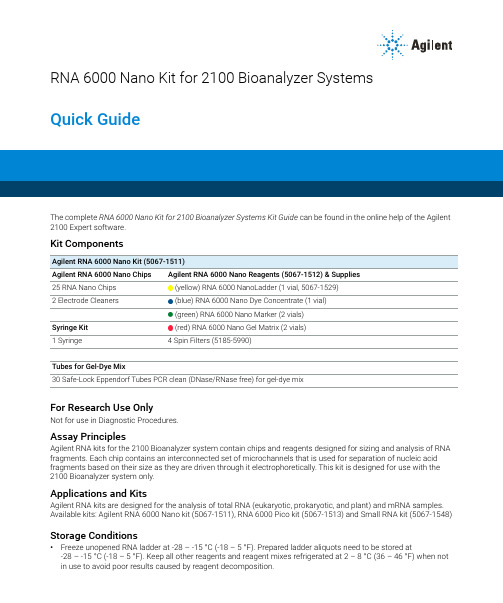
RNA 6000 Nano Kit for 2100 Bioanalyzer SystemsQuick GuideThe complete RNA 6000 Nano Kit for 2100 Bioanalyzer Systems Kit Guide can be found in the online help of the Agilent 2100 Expert software.Kit ComponentsAgilent RNA 6000 Nano Kit (5067-1511)Agilent RNA 6000 Nano Chips Agilent RNA 6000 Nano Reagents (5067-1512) & Supplies25 RNA Nano Chips (yellow) RNA 6000 NanoLadder (1 vial, 5067-1529)2 Electrode Cleaners (blue) RNA 6000 Nano Dye Concentrate (1 vial)(green) RNA 6000 Nano Marker (2 vials)Syringe Kit (red) RNA 6000 Nano Gel Matrix (2 vials)1Syringe 4 Spin Filters (5185-5990)Tubes for Gel-Dye Mix30 Safe-Lock Eppendorf Tubes PCR clean (DNase/RNase free) for gel-dye mixFor Research Use OnlyNot for use in Diagnostic Procedures.Assay PrinciplesAgilent RNA kits for the 2100 Bioanalyzer system contain chips and reagents designed for sizing and analysis of RNA fragments. Each chip contains an interconnected set of microchannels that is used for separation of nucleic acid fragments based on their size as they are driven through it electrophoretically. This kit is designed for use with the 2100 Bioanalyzer system only.Applications and KitsAgilent RNA kits are designed for the analysis of total RNA (eukaryotic, prokaryotic, and plant) and mRNA samples. Available kits: Agilent RNA 6000 Nano kit (5067-1511), RNA 6000 Pico kit (5067-1513) and Small RNA kit (5067-1548) Storage Conditions•Freeze unopened RNA ladder at -28–-15°C (-18–5°F). Prepared ladder aliquots need to be stored at -28–-15°C (-18–5°F). Keep all other reagents and reagent mixes refrigerated at 2–8°C (36–46°F) when not in use to avoid poor results caused by reagent decomposition.2•Protect dye and dye mixtures from light. Remove light covers only when pipetting. Dye decomposes when exposed to light.•Store the chips at room temperature.Equipment Supplied with the Agilent 2100 Bioanalyzer System•Chip priming station (5065-4401)•IKA vortex mixerAdditional Material Required (Not Supplied)•RNaseZAP® recommended for electrode decontamination and routine electrode cleaning •RNase-free water recommended for routine electrode cleaning•Pipettes (10µL and 1000µL) with compatible tips (RNase-free, no filter tips, no autoclaved tips)•0.5mL and 1.5mL microcentrifuge tubes (RNase-free)•Microcentrifuge ( 13000g)•Heating block or water bath for ladder/sample preparationSample preparationFor total RNA or mRNA analysis, the sample concentration must be within the specified range. If the concentration of your particular sample is above this range, dilute with RNase-free water.SpecificationsSetting up the Chip Priming Station1Replace the syringe:a Unscrew the old syringe from the lid of the chip priming station.b Release the old syringe from the clip. Discard the old syringe.c Remove the plastic cap of the new syringe and insert it into the clip.d Slide it into the hole of the luer lock adapter and screw it tightly to the chip priming station.2Adjust the base plate:a Open the chip priming station by pulling the latch.b Using a screwdriver, open the screw at the underside of the base plate.c Lift the base plate and insert it again in position C. Retighten the screw.Physical Specifications Analytical SpecificationsTotal RNA AssaymRNA Assay Analysis time30min Quantitative range 25–500ng/µL 25–250ng/µL Samples per chip 12Qualitative range 5–500ng/µL 5–250ng/µL Sample volume 1µL Sensitivity (S/N>3)5ng/µL in water25ng/µL in water Kit stability 4 months Quantitative precision (within a chip)10% CV 10% CV Kit size25 chips12 samples/chip = 300 samples/kitQuantitative accuracy11Determined analyzing the RNA ladder as sample20%20%Maximum salt concentration in sample100mM Tris 0.1mM EDTA or 125mM NaCl 15mM MgCl 2100mM Tris 0.1mM EDTA or 125mM NaCl 15mM MgCl 233Adjust the syringe clip:a Release the lever of the clip and slide it up to the top position.Essential Measurement Practices•Handle and store all reagents according to the instructions on the label of the individual box.•Avoid sources of dust or other contaminants. Foreign matter in reagents and samples or in the wells of the chip will interfere with assay results.•Allow all reagents to equilibrate to room temperature for 30min before use. Thaw samples on ice.•Protect dye and dye mixtures from light. Remove light covers only when pipetting. The dye decomposes when exposed to light and this reduces the signal intensity.•Always insert the pipette tip to the bottom of the well when dispensing the liquid. Placing the pipette at the edge of the well may lead to poor results.•Always wear gloves when handling RNA and use RNase-free tips, microcentrifuge tubes and water.•It is recommended to heat denature all RNA samples and RNA ladder before use for 2min and 70°C (once) and keep them on ice.•Do not touch the 2100 Bioanalyzer instrument during analysis and never place it on a vibrating surface.•Always vortex the dye concentrate for 10s before preparing the gel-dye mix and spin down afterwards.•Use a new syringe and electrode cleaners with each new kit.•Use loaded chips within 5min after preparation. Reagents might evaporate, leading to poor results.•To prevent contamination (e.g. RNase), it is strongly recommended to use a dedicated electrode cartridge for RNA assays.•Perform the RNase decontamination procedure for the electrodes daily before running any assays. Refer to the kit guide for details on electrode cleaning and decontamination.Agilent RNA 6000 Nano Assay ProtocolPreparing the RNA Ladder1Spin the ladder down and pipette in an RNase-free vial.2Heat denature the ladder for 2min at 70°C.3Immediately cool the vial on ice.4Prepare aliquots in recommended 0.5mL RNase-free vials with the required amount for typical daily use.5Store aliquots at -28–-15°C (-18–5°F). After initial heat denaturation, the frozen aliquots should not require repeated heat denaturation.6Before use, thaw ladder aliquots on ice (avoid extensive warming).Preparing the Gel1Pipette 550µL of RNA gel matrix (red ) into a spin filter.2Centrifuge at 1500 g ±20% for 10min at room temperature.3Aliquot 65µL filtered gel into 0.5mL RNase-free microcentrifuge tubes. Use filtered gel within 4 weeks. Store at2–8°C (36–46°F).Handling ReagentsThe dye can cause eye irritation. Because the dye binds to nucleic acids, it should be treated as a potential mutagen.Kit components contain DMSO. DMSO is skin-permeable and can elevate the permeability of other substances through the skin.✓Follow the appropriate safety procedures and wear personal protective equipment including protective gloves and clothes as well as eye protection.✓Follow good laboratory practices when preparing and handling reagents and samples.✓Always use reagents with appropriate care.✓For more information, refer to the material safety data sheet (MSDS) on .Agilent Technologies Inc. 2001-2022Printed in Germany, Edition: 11/2022*G2938-90037*Part No: G2938-90037 Rev. E.00Document No: SD-UF0000031 Rev. E.00Allow the RNA dye concentrate (blue ) to equilibrate to room temperatureVortex RNA dye concentrate (blue ) for 10µL of RNA marker (green ) in all 12sample wells and in the well marked.to find information on your local Contact Visit the Agilent website. It offers useful information, support, and current developments about the products and /en/product/automated-electrophoresis/bioanalyzer-systems .Put a new RNA chip on the chip priming station.µL of gel-dye mix in the well marked .mL and then close the chip priming µL of gel-dye mix in the wells marked .µL of prepared ladder in well marked .Pipette 1µL of sample in each of the 12 sample wells. Pipette 1(green ) in each unused sample well.Put the chip horizontally in the IKA vortexer and vortex for 1 9 µl gel-dye 9 µl gel-dye1 µl ladder 1 µl sample5 µl marker。
fitc-bsa结构式
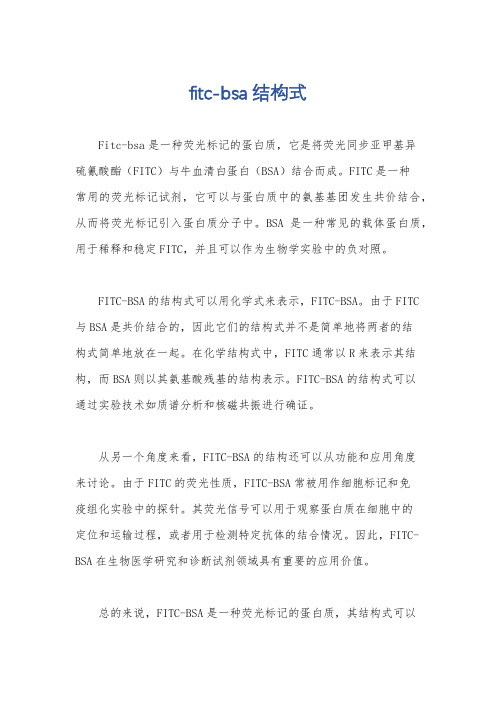
fitc-bsa结构式
Fitc-bsa是一种荧光标记的蛋白质,它是将荧光同步亚甲基异
硫氰酸酯(FITC)与牛血清白蛋白(BSA)结合而成。
FITC是一种
常用的荧光标记试剂,它可以与蛋白质中的氨基基团发生共价结合,从而将荧光标记引入蛋白质分子中。
BSA是一种常见的载体蛋白质,用于稀释和稳定FITC,并且可以作为生物学实验中的负对照。
FITC-BSA的结构式可以用化学式来表示,FITC-BSA。
由于FITC
与BSA是共价结合的,因此它们的结构式并不是简单地将两者的结
构式简单地放在一起。
在化学结构式中,FITC通常以R来表示其结构,而BSA则以其氨基酸残基的结构表示。
FITC-BSA的结构式可以
通过实验技术如质谱分析和核磁共振进行确证。
从另一个角度来看,FITC-BSA的结构还可以从功能和应用角度
来讨论。
由于FITC的荧光性质,FITC-BSA常被用作细胞标记和免
疫组化实验中的探针。
其荧光信号可以用于观察蛋白质在细胞中的
定位和运输过程,或者用于检测特定抗体的结合情况。
因此,FITC-BSA在生物医学研究和诊断试剂领域具有重要的应用价值。
总的来说,FITC-BSA是一种荧光标记的蛋白质,其结构式可以
用化学式FITC-BSA来表示。
它在生物学实验和生物医学研究中具有重要的应用价值,可以帮助科研人员观察蛋白质的行为和进行相关的实验研究。
CB 107A IEC60950-1 draft (DC_DC)
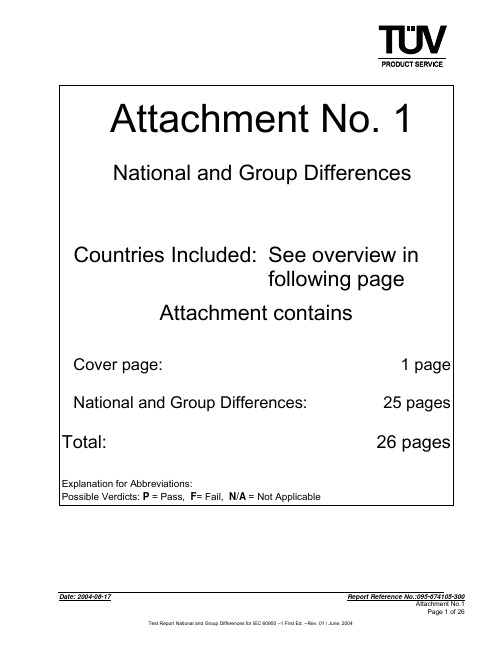
P P N/A N/A N/A
Minimum conductor sizes Nominal cross-sectional area mm² AWG or kcmil (crosssectional area in mm²) see Note 2
Date: 2004-06-17
Report Reference No.:095-674105-300 Attachment No.1 Page 2 of 26
Test Report National and Group Differences for IEC 60950 –1 First Ed. --Rev. 01 / June, 2004
COUNTRY GROUP DIFFERENCES YES YES NATIONAL DIFFERENCES YES YES EN 60950-1:2001 AS 60950.1-2003 EN 60950-1:2001 CAN/CSA C22.2 No. 60950-1/ UL60950-1 EN 60950-1:2001 EN 60950-1:2001 EN 60950-1:2001 BS EN 60950-1:2001 EN 60950-1:2001 NATIONAL STANDARD
YES YES YES YES YES YES YES YES YES
YES YES YES YES YES YES YES YES YES UL 60950-1 SS-EN 60950-1 EN 60950-1:2001 K60950 IS 13252:2003
1)
4.3.13.5 4.7 4.7.201
N/A N/A P
BS107AG中文资料
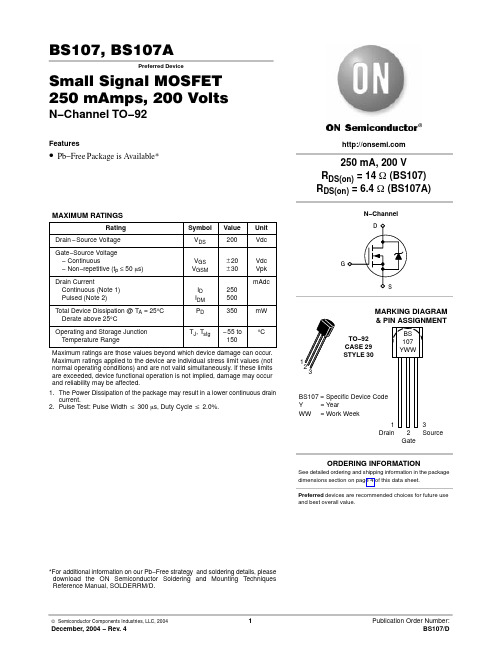
BS107, BS107APreferred DeviceSmall Signal MOSFET 250 mAmps, 200 VoltsN−Channel TO−92Features•Pb−Free Package is Available*Maximum ratings are those values beyond which device damage can occur. Maximum ratings applied to the device are individual stress limit values (not normal operating conditions) and are not valid simultaneously. If these limits are exceeded, device functional operation is not implied, damage may occur and reliability may be affected.1.The Power Dissipation of the package may result in a lower continuous draincurrent.2.Pulse Test: Pulse Width v 300 m s, Duty Cycle v 2.0%.*For additional information on our Pb−Free strategy and soldering details, please download the ON Semiconductor Soldering and Mounting Techniques Reference Manual, SOLDERRM/D.Preferred devices are recommended choices for future use and best overall value.See detailed ordering and shipping information in the package dimensions section on page 4 of this data sheet.ORDERING INFORMATIONRESISTIVE SWITCHINGFigure 1. Switching Test Circuit Figure 2. Switching WaveformsV DS , DRAIN −S OURCE VOLTAGE (VOLTS)V GS, GATE −S OURCE VOLTAGE (VOLTS)105.02.01.00.50.20.1, D R A I N −S O U R C E V O L T A G E (V O L T S )00.30.20.10.40.60.5, D R A IN C U R R E N T (A M P S )D (o n )I V DS , DRAIN −S OURCE VOLTAGE (VOLTS)0.80.7C , C A P A C I T A N C E (p F )T J , JUNCTION TEMPERATURE (°C)060402080120100160140200180V D S Figure 3. On Voltage versus Temperature Figure 4. Capacitance VariationFigure 5. Transfer Characteristic Figure 6. Output CharacteristicV DS , DRAIN −S OURCE VOLTAGE (VOLTS), D R A I N C U R R E N T (A M P S )D (o n )I 0.30.20.10.40.60.50.7Figure 7. Saturation CharacteristicORDERING INFORMATION†For information on tape and reel specifications, including part orientation and tape sizes, please refer to our T ape and Reel Packaging Specifi-cations Brochure, BRD8011/D.PACKAGE DIMENSIONSTO−92 (TO−226)CASE 29−11ISSUE ALNOTES:1.DIMENSIONING AND TOLERANCING PER ANSIY14.5M, 1982.2.CONTROLLING DIMENSION: INCH.3.CONTOUR OF PACKAGE BEYOND DIMENSION RIS UNCONTROLLED.4.LEAD DIMENSION IS UNCONTROLLED IN P ANDBEYOND DIMENSION K MINIMUM.PLANEDIM MIN MAX MIN MAXMILLIMETERSINCHESA0.1750.205 4.45 5.20 B0.1700.210 4.32 5.33 C0.1250.165 3.18 4.19 D0.0160.0210.4070.533 G0.0450.055 1.15 1.39 H0.0950.105 2.42 2.66 J0.0150.0200.390.50 K0.500−−−12.70−−−L0.250−−− 6.35−−−N0.0800.105 2.04 2.66 P−−−0.100−−− 2.54 R0.115−−− 2.93−−−V0.135−−− 3.43−−−STYLE 30:PIN 1.DRAIN2.GATE3.SOURCEON Semiconductor and are registered trademarks of Semiconductor Components Industries, LLC (SCILLC). SCILLC reserves the right to make changes without further notice to any products herein. SCILLC makes no warranty, representation or guarantee regarding the suitability of its products for any particular purpose, nor does SCILLC assume any liability arising out of the application or use of any product or circuit, and specifically disclaims any and all liability, including without limitation special, consequential or incidental damages.“Typical” parameters which may be provided in SCILLC data sheets and/or specifications can and do vary in different applications and actual performance may vary over time. All operating parameters, including “Typicals” must be validated for each customer application by customer’s technical experts. SCILLC does not convey any license under its patent rights nor the rights of others. SCILLC products are not designed, intended, or authorized for use as components in systems intended for surgical implant into the body, or other applications intended to support or sustain life, or for any other application in which the failure of the SCILLC product could create a situation where personal injury or death may occur. Should Buyer purchase or use SCILLC products for any such unintended or unauthorized application, Buyer shall indemnify and hold SCILLC and its officers, employees, subsidiaries, affiliates, and distributors harmless against all claims, costs, damages, and expenses, and reasonable attorney fees arising out of, directly or indirectly, any claim of personal injury or death associated with such unintended or unauthorized use, even if such claim alleges that SCILLC was negligent regarding the design or manufacture of the part. SCILLC is an Equal Opportunity/Affirmative Action Employer. This literature is subject to all applicable copyright laws and is not for resale in any manner.PUBLICATION ORDERING INFORMATION。
AATCC 107- 2013
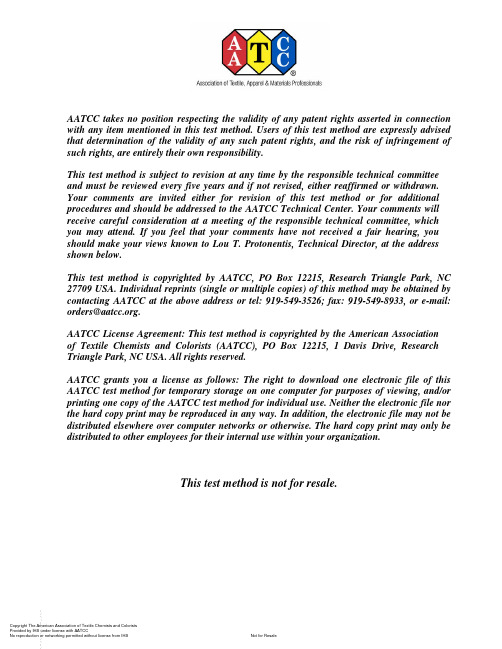
AATCC takes no position respecting the validity of any patent rights asserted in connectionwith any item mentioned in this test method. Users of this test method are expressly advisedthat determination of the validity of any such patent rights, and the risk of infringement ofsuch rights, are entirely their own responsibility.This test method is subject to revision at any time by the responsible technical committeeand must be reviewed every five years and if not revised, either reaffirmed or withdrawn.Your comments are invited either for revision of this test method or for additionalprocedures and should be addressed to the AATCC Technical Center. Your comments willreceive careful consideration at a meeting of the responsible technical committee, whichyou may attend. If you feel that your comments have not received a fair hearing, youshould make your views known to Lou T. Protonentis, Technical Director, at the addressshown below.This test method is copyrighted by AATCC, PO Box 12215, Research Triangle Park, NC27709 USA. Individual reprints (single or multiple copies) of this method may be obtained bycontacting AATCC at the above address or tel: 919-549-3526; fax: 919-549-8933, or e-mail:orders@.AATCC License Agreement: This test method is copyrighted by the American Associationof Textile Chemists and Colorists (AATCC), PO Box 12215, 1 Davis Drive, ResearchTriangle Park, NC USA. All rights reserved.AATCC grants you a license as follows: The right to download one electronic file of thisAATCC test method for temporary storage on one computer for purposes of viewing, and/orprinting one copy of the AATCC test method for individual use. Neither the electronic file northe hard copy print may be reproduced in any way. In addition, the electronic file may not bedistributed elsewhere over computer networks or otherwise. The hard copy print may only bedistributed to other employees for their internal use within your organization.This test method is not for resale.Copyright The American Association of Textile Chemists and ColoristsDeveloped in 1962 by AATCC Commit-tee RA23; revised 1967, 1968, 1972, 1981, 2009, 2012, 2013; rea ffirmed 1975, 1978, 1989, 2007; editorially re-vised 1983, 1985, 1994, 2001, 2005, 2008, 2010; editorially revised and re-affirmed 1986, 1991, 1997, 2002. Tech-nically equivalent to ISO 105-E01.1. Purpose and Scope1.1 This test method is designed to measure the resistance to water of dyed, printed, or otherwise colored textile yarns and fabrics.1.2 Distilled water or deionized water is used in this test method because natural (tap) water is variable in composition.2. Principle2.1 The specimen, backed by multifi-ber test fabric, is immersed in water un-der specified conditions of temperature and time, and then placed between glass or plastic plates under specified condi-tions of pressure, temperature and time. The change in color of the specimen and the staining of the attached multifiber test fabric are observed.3. Terminology3.1 colorfastness, n.—the resistance ofa material to change in any of its color characteristics, to transfer of its color-ant(s) to adjacent materials or both, as a result of the exposure of the material to any environment that might be encoun-tered during the processing, testing, stor-age or use of the material.4. Safety PrecautionsNOTE: These safety precautions are for information purposes only. The pre-cautions are ancillary to the testing proce-dures and are not intended to be all inclu-sive. It is the user’s responsibility to use safe and proper techniques in handling materials in this test method. Manufac-turers MUST be consulted for specific details such as material safety data sheets and other manufacturer’s recommenda-tions. All OSHA standards and rules must also be consulted and followed. 4.1 Good laboratory practices should be followed. Wear safety glasses in all laboratory areas.4.2 Manufacturer’s safety recommen-dations should be followed when operat-ing laboratory testing equipment.4.3 Observe padder safety. Ensure ade-quate guard at the nip point. Normal safe-guards on pad should not be removed.5. Apparatus and Materials (see 12.1)5.1 Perspiration tester (plastic or glassplates are available with the equipment)(see 12.2).5.2 Drying oven—convection.5.3 Multifiber test fabrics (8 mm [0.33in.] bands) containing acetate, cotton,nylon, silk, viscose rayon and wool shallbe used for specimens containing silk, or(8mm [0.33 in.] bands) containing ace-tate, cotton, nylon, polyester, acrylic andwool shall be used for specimens with nosilk present.5.4 AA TCC 9-Step Chromatic Trans-ference Scale (AATCC Evaluation Proce-dure 8) (see 12.3).5.5 Gray Scale for Color Change(AATCC Evaluation Procedure 1) andGray Scale for Staining (AA TCC Evalua-tion Procedure 2) (see 12.3).5.6 Wringer.6. Test Solution6.1 Distilled water or deionized waterfrom an ion-exchange device.7. Test Specimens7.1 If the specimen to be tested is afabric, attach a piece of multifiber adja-cent fabric also measuring 5 × 5 ± 0.2 tothe specimen measuring 6 × 6 ± 0.2 cmby sewing along one of the shorter sides,with the multifiber fabric next to the faceof the specimen.7.2 If the specimen to be tested is ayarn or loose fiber, take a mass of theyarn or loose fiber approximately equalto one half of the combined mass of theadjacent fabrics. Place it between a 5 × 5± 0.2 cm piece of multifiber fabric and a6 × 6 ± 0.2 cm piece of the non-dyeablefabric, and sew along all four sides.8. Procedure8.1 Immerse the test specimen in thetest solution which is at room tempera-ture with occasional agitation to ensurethorough wetting out (approximately 15min generally required for average fab-rics) (see 12.4).8.2 Remove the test specimen from thetest solution and only pass betweensqueeze rolls (wringer) to remove excessliquor when the wet weight of the testspecimen is more than 3 times its dryweight. Whenever possible, the wetweight should be 2.5-3.0 times the dryweight.8.3 Place the test specimen betweenglass or plastic plates and insert in thespecimen unit of the perspiration tester.Adjust the perspiration tester to produce apressure of 4.5 kg (10.0 lb) on the testspecimen (see 12.2).8.4 Heat the loaded specimen unit in anoven at 38 ± 1°C (100 ± 2°F) for 18 h.8.5 Remove the tester from the ovenand for each test specimen assembly, sep-arate the multifiber fabric and, if used,the adjacent fabric from the test fabric.Place the multifiber fabric and test fabricspecimens separately on a wire screen ina conditioned atmosphere 21 ± 1°C (70 ±2°F) and 65 ± 2% relative humidity over-night.9. Evaluation Method for Color Change9.1 Evaluate the test specimen forchange in color by comparison with theGray Scale for Color Change (AATCCEvaluation Procedure 1), or by usingAATCC Evaluation Procedure 7, Instru-mental Assessment of the Change inColor of a Test Specimen, and record thenumerical rating that corresponds to theappropriate one on the Gray Scale.10. Evaluation Method for Staining (see12.7)10.1 Evaluate the staining of the multi-fiber fabric used (see 12.5) by compari-son with the Gray Scale for Staining(AATCC Evaluation Procedure 2), theAATCC 9-Step Chromatic TransferenceScale (AA TCC Evaluation Procedure 8),or Instrumental Assessment of Degree ofStaining (AATCC Evaluation Procedure12), and record the numerical rating thatcorresponds to the appropriate one on ei-ther of them. Report which scale is used(see 12.6).11. Precision and Bias11.1 Precision. Precision for this testmethod has not been established. Until aprecision statement is generated for thistest method, use standard statistical tech-niques in making any comparisons of testresults for either within-laboratory orbetween-laboratory averages.11.2 Bias. Colorfastness to water canbe defined only in terms of a test method.There is no independent method for de-termining the true value. As a means ofestimating this property, the method hasno known bias.AATCC Test Method 107-2013Colorfastness to Water--`,,```,,,,````-`-`,,`,,`,`,,`---AATCC Technical Manual/2014TM 107-201317912. Notes12.1 For potential equipment information pertaining to this test method, please visit the online AATCC Buyer’s Guide at http:// /bg. AATCC provides the pos-sibility of listing equipment and materials sold by its Corporate members, but AATCC does not qualify, or in any way approve, endorse or certify that any of the listed equipment or materials meets the requirements in its test methods.12.2 Horizontal Perspiration Tester: Put all 21 glass or plastic plates into the unit regardless of the number of specimens. After the final glass or plastic plate is put in position on top, set the dual plates with compensating springs in position. Place the 3.6 kg (8.0 lb) weight on top making a total of 4.5 kg (10.0 lb) under the pressure plate. Lock the pressure plate in position by turning the thumb-screws. Removethe weight. Place the unit in the oven on its side,so that the plates and the specimens are vertical.Vertical Perspiration Tester: The plates areheld in a vertical position between an indicat-ing scale with a fixed metal plate at one endand an adjustable metal plate at the other end.By means of adjusting screws, the movableplate may be made to exert increasing pressureagainst the test specimens. When the desiredpressure of 4.5 kg (10.0 lb) is indicated on thescale, lock the specimen in it by a set screw.The specimen unit can now be removed fromthe section applying the pressure. Anotherspecimen unit can be added to the pressuresection and the loading procedure repeated.12.3 Available from AATCC, P.O. Box12215, Research Triangle Park NC 27709; tel:+1.919.549.8141; fax: +1.919.549.8933; e-mail:orders@; web site: .12.4 Or immerse the test specimen in thetest solution at room temperature, passthrough squeeze rolls (wringer) and reim-merse. Repeat, if necessary, to attain thoroughwetting out.12.5 Classify according to the fiber show-ing the greatest stain.12.6 For very critical evaluations and incases of arbitration, ratings must be based onthe Gray Scale for Staining.12.7 CAUTION: It has been reported thatthe results for staining obtained by thismethod on fabrics dyed to dark shades (navy,black, etc.) that contain a combination of poly-ester and spandex, or their blends, may notshow the full staining propensity of such fab-rics in consumer use. It is, therefore, recom-mended that the staining results obtained bythis test not be used for the acceptance testingof such fabrics.--`,,```,,,,````-`-`,,`,,`,`,,`---180TM 107-2013AATCC Technical Manual/2014。
结构胶107含量
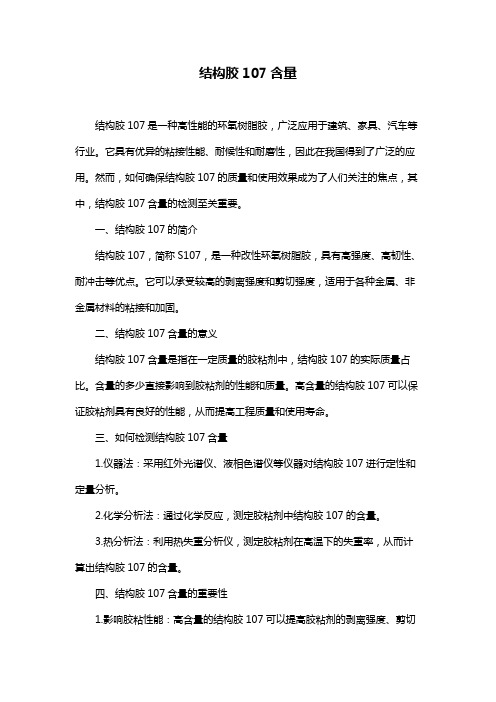
结构胶107含量结构胶107是一种高性能的环氧树脂胶,广泛应用于建筑、家具、汽车等行业。
它具有优异的粘接性能、耐候性和耐磨性,因此在我国得到了广泛的应用。
然而,如何确保结构胶107的质量和使用效果成为了人们关注的焦点,其中,结构胶107含量的检测至关重要。
一、结构胶107的简介结构胶107,简称S107,是一种改性环氧树脂胶,具有高强度、高韧性、耐冲击等优点。
它可以承受较高的剥离强度和剪切强度,适用于各种金属、非金属材料的粘接和加固。
二、结构胶107含量的意义结构胶107含量是指在一定质量的胶粘剂中,结构胶107的实际质量占比。
含量的多少直接影响到胶粘剂的性能和质量。
高含量的结构胶107可以保证胶粘剂具有良好的性能,从而提高工程质量和使用寿命。
三、如何检测结构胶107含量1.仪器法:采用红外光谱仪、液相色谱仪等仪器对结构胶107进行定性和定量分析。
2.化学分析法:通过化学反应,测定胶粘剂中结构胶107的含量。
3.热分析法:利用热失重分析仪,测定胶粘剂在高温下的失重率,从而计算出结构胶107的含量。
四、结构胶107含量的重要性1.影响胶粘性能:高含量的结构胶107可以提高胶粘剂的剥离强度、剪切强度等性能,确保粘接效果。
2.影响耐久性能:结构胶107含量越高,胶粘剂的耐候性、耐磨性越好,延长使用寿命。
3.影响安全性能:确保结构胶107含量达到标准,可以降低胶粘剂中有害物质的含量,保障人身安全。
五、总结结构胶107含量在胶粘剂的品质控制中具有重要意义。
通过对结构胶107含量的检测,可以确保胶粘剂的性能和质量,从而提高工程质量和使用寿命。
在选购结构胶107时,应注意选择正规厂家和合格产品,确保结构胶107含量的达标。
裸芯片种类
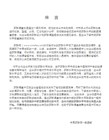
LF351LF353LF356LF357LF411LF412LF441ALF442LF444LM107
LM108LM108ALM118LM12LM124LM143LM1458LM148LM1556LM158
缓冲放大器
HA0-5002HA0-5033HA-5002HAO-5033
测量放大器
AD524AD620AD622AD623AD624AD625AD627AMP02FSINA110INA111
INA118INA122INA128INA128AINA129NA129AINA163INA2321INA321LTC6800
TMS29F040X76F100
随机存取存储器(RAM)
IDT6116SAUIDT7026IDT7164IS61LV12816LIS61LV5128ALK4H561638DK6R4008CIDK6R4016V1DMK68345MT28C6428P18
LT1057CLT1494LT1495LT1803LT1880LT6233LTC1052MA01MAX4020MAX407
MAX4385EMAX4472MAX492MAX495MC1456MC1536MC1537MC1556MC3303MC33171
MC3503MC4741MCC1536MSK103NE5532OP07GBCOP07GRBCOP07NBCOP09OP11GBC
可变增益放大器
AD603AAD604SAD8367AD8369THS7530VCA810
视频放大器
AD813LM733LT1227TL592UA733C
Fluke 温度仪说明书
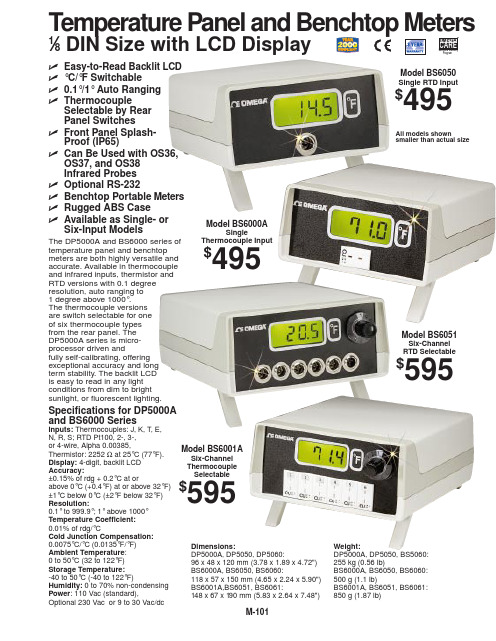
Temperature Panel and Benchtop Meters1⁄8DIN Size with LCD DisplayModel BS6000ASingleThermocouple Input$495Model BS6050Single RTD Input$495Model BS6051Six-Channel RTD Selectable$595Specifications for DP5000A and BS6000 SeriesInputs:Thermocouples: J, K, T, E, N, R, S; RTD Pt100, 2-, 3-, or 4-wire, Alpha 0.00385,Thermistor: 2252 Ωat 25°C (77°F).Display: 4-digit, backlit LCD Accuracy:±0.15% of rdg + 0.2°C at orabove 0°C (+0.4°F) at or above 32°F)±1°C below 0°C (±2°F below 32°F)Resolution:0.1°to 999.9°; 1°above 1000°Temperature Coefficient:0.01% of rdg/°CCold Junction Compensation: 0.0075°C/°C (0.0135°F/°F)Ambient Temperature : 0 to 50°C (32 to 122°F)Storage Temperature:-40 to 50°C (-40 to 122°F)Humidity: 0 to 70% non-condensing Power : 110 Vac (standard),Optional 230 Vac or 9 to 30 Vac/dcM-101ߜEasy-to-Read Backlit LCD ߜ°C/°F Switchable ߜ0.1°/1°Auto Ranging ߜThermocouple Selectable by Rear Panel SwitchesߜFront Panel Splash-Proof (IP65)ߜCan Be Used with OS36, OS37, and OS38 Infrared Probes ߜOptional RS-232ߜBenchtop Portable Meters ߜRugged ABS Case ߜAvailable as Single- or Six-Input ModelsDimensions:DP5000A, DP5050, DP5060:96 x 48 x 120 mm (3.78 x 1.89 x 4.72")BS6000A, BS6050, BS6060:118 x 57 x 150 mm (4.65 x 2.24 x 5.90")BS6001A,BS6051, BS6061:148 x 67 x 190 mm (5.83 x 2.64 x 7.48")Weight:DP5000A, DP5050, BS5060: 255 kg (0.56 lb)BS6000A, BS6050, BS6060: 500 g (1.1 lb)BS6001A, BS6051, BS6061: 850 g (1.87 lb)The DP5000A and BS6000 series of temperature panel and benchtop meters are both highly versatile and accurate. Available in thermocouple and infrared inputs, thermistor and RTD versions with 0.1 degree resolution, auto ranging to 1 degree above 1000°. The thermocouple versions are switch selectable for one of six thermocouple types from the rear panel. The DP5000A series is micro-processor driven andfully self-calibrating, offering exceptional accuracy and long term stability. The backlit LCD is easy to read in any light conditions from dim to bright sunlight, or fluorescent lighting.To Order (Specify Model Number)Model No.Price DescriptionDP5000A $245T/C input panel meter with infrared sensor input*DP5050245RTD input panel meterDP5060245Thermistor input panel meterBS6000A*495Benchtop meter: 1 T/C and OS36, OS37 OS38 input BS6001A*595Benchtop meter: 6 T/C and OS36, OS37 OS38 inputs BS6050495Benchtop meter: 1 RTD input BS6051595Benchtop meter: 6 RTD inputBS6060495Benchtop meter: 1 thermistor input BS6061595Benchtop meter: 6 thermistor inputsMDP5000A Series$245ShownModel OS36-K-50 probe, $185See Section JShown smaller than actual sizeModel NumberPriceDescriptionDP5000-BRACKETS $7Replacement panel bracketsDP5000-SBRACKETS7Panel brackets with adjustable screwsAccessoriesModel NumberPriceDescription-9/30N/C 9 to 30 Vac/Vdc -230N/C230 VacPower OptionsOrder SuffixPriceDescription-C2$40RS-232 communicationsCommunications OptionsInputRangeIron-Constantan-200 to 1200˚C -328 to 2192˚F CHROMEGA ®- ALOMEGA ®-200 to 1372˚C -328 to 2502˚F CHROMEGA ®- Constantan -200 to 1000˚C -328 to 1832˚F Copper - Constantan-200 to 400˚C -328 to 752˚F Platinum - 10% Rhodium/ Platinum -50 to 1767˚C -58 to 3212˚F Platinum - 13% Rhodium/ Platinum -50 to 1767˚C -58 to 3212˚F OMEGA-P ®- Nicrosil -200 to 1300˚C -328 to 2372˚FOMEGA-N ®- NisilInput Ranges for DP5000 and BS6000 Series* Can be used with OS36-K-50and OS36-K-440. Also will work with OS37and OS38units with either 20:1 or 100:1 fields of view. Comes complete with power cord, mating connector(s), operators’ manual. OMEGACARE SM extended warranty program is available for models shown on this page. Ask your sales representative for full details when placing an order.Ordering Example: BS6050-C2,single RTD input benchtop thermometer and RS-232 communications, $495 + 40 = $535. OCW-1 OMEGACARE SM extends standard 3-year warranty to a total of 4 years ($53), $535 + 53 = $588J K E T S R NCANADA www.omega.ca Laval(Quebec) 1-800-TC-OMEGA UNITED KINGDOM www. Manchester, England0800-488-488GERMANY www.omega.deDeckenpfronn, Germany************FRANCE www.omega.frGuyancourt, France088-466-342BENELUX www.omega.nl Amstelveen, NL 0800-099-33-44UNITED STATES 1-800-TC-OMEGA Stamford, CT.CZECH REPUBLIC www.omegaeng.cz Karviná, Czech Republic596-311-899TemperatureCalibrators, Connectors, General Test and MeasurementInstruments, Glass Bulb Thermometers, Handheld Instruments for Temperature Measurement, Ice Point References,Indicating Labels, Crayons, Cements and Lacquers, Infrared Temperature Measurement Instruments, Recorders Relative Humidity Measurement Instruments, RTD Probes, Elements and Assemblies, Temperature & Process Meters, Timers and Counters, Temperature and Process Controllers and Power Switching Devices, Thermistor Elements, Probes andAssemblies,Thermocouples Thermowells and Head and Well Assemblies, Transmitters, WirePressure, Strain and ForceDisplacement Transducers, Dynamic Measurement Force Sensors, Instrumentation for Pressure and Strain Measurements, Load Cells, Pressure Gauges, PressureReference Section, Pressure Switches, Pressure Transducers, Proximity Transducers, Regulators,Strain Gages, Torque Transducers, ValvespH and ConductivityConductivity Instrumentation, Dissolved OxygenInstrumentation, Environmental Instrumentation, pH Electrodes and Instruments, Water and Soil Analysis InstrumentationHeatersBand Heaters, Cartridge Heaters, Circulation Heaters, Comfort Heaters, Controllers, Meters and SwitchingDevices, Flexible Heaters, General Test and Measurement Instruments, Heater Hook-up Wire, Heating Cable Systems, Immersion Heaters, Process Air and Duct, Heaters, Radiant Heaters, Strip Heaters, Tubular HeatersFlow and LevelAir Velocity Indicators, Doppler Flowmeters, LevelMeasurement, Magnetic Flowmeters, Mass Flowmeters,Pitot Tubes, Pumps, Rotameters, Turbine and Paddle Wheel Flowmeters, Ultrasonic Flowmeters, Valves, Variable Area Flowmeters, Vortex Shedding FlowmetersData AcquisitionAuto-Dialers and Alarm Monitoring Systems, Communication Products and Converters, Data Acquisition and Analysis Software, Data LoggersPlug-in Cards, Signal Conditioners, USB, RS232, RS485 and Parallel Port Data Acquisition Systems, Wireless Transmitters and Receivers。
结构胶107含量
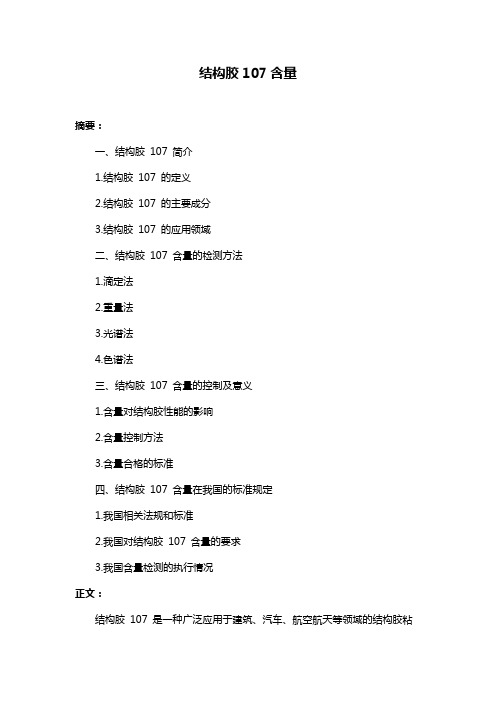
结构胶107含量
摘要:
一、结构胶107 简介
1.结构胶107 的定义
2.结构胶107 的主要成分
3.结构胶107 的应用领域
二、结构胶107 含量的检测方法
1.滴定法
2.重量法
3.光谱法
4.色谱法
三、结构胶107 含量的控制及意义
1.含量对结构胶性能的影响
2.含量控制方法
3.含量合格的标准
四、结构胶107 含量在我国的标准规定
1.我国相关法规和标准
2.我国对结构胶107 含量的要求
3.我国含量检测的执行情况
正文:
结构胶107 是一种广泛应用于建筑、汽车、航空航天等领域的结构胶粘
剂。
其主要成分包括聚氨酯预聚物、固化剂、增塑剂、稀释剂等。
为了保证结构胶107 的性能和质量,对其含量进行准确检测至关重要。
结构胶107 含量的检测方法有多种,如滴定法、重量法、光谱法和色谱法等。
其中,滴定法和重量法是最常用的方法,具有操作简便、结果准确等优点。
光谱法和色谱法则具有高精度、高灵敏度等特点,适用于对结构胶107 含量进行微量分析。
结构胶107 含量的控制对产品性能具有重要影响。
一般来说,含量过高可能导致结构胶性能过于强烈,难以操作;含量过低则可能影响粘接强度和耐久性。
因此,生产过程中需要严格控制结构胶107 的含量,以保证产品质量。
我国对结构胶107 含量的要求参照相关法规和标准,如GB/T 14684-2011《建筑结构胶粘剂》等。
cd107a实验流程
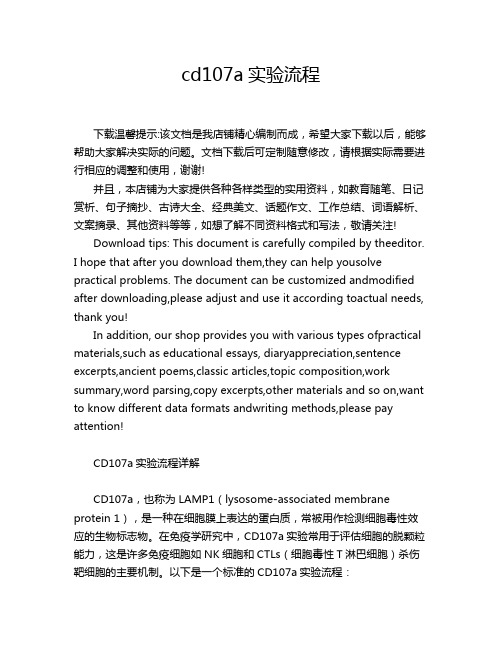
cd107a实验流程下载温馨提示:该文档是我店铺精心编制而成,希望大家下载以后,能够帮助大家解决实际的问题。
文档下载后可定制随意修改,请根据实际需要进行相应的调整和使用,谢谢!并且,本店铺为大家提供各种各样类型的实用资料,如教育随笔、日记赏析、句子摘抄、古诗大全、经典美文、话题作文、工作总结、词语解析、文案摘录、其他资料等等,如想了解不同资料格式和写法,敬请关注!Download tips: This document is carefully compiled by theeditor.I hope that after you download them,they can help yousolve practical problems. The document can be customized andmodified after downloading,please adjust and use it according toactual needs, thank you!In addition, our shop provides you with various types ofpractical materials,such as educational essays, diaryappreciation,sentence excerpts,ancient poems,classic articles,topic composition,work summary,word parsing,copy excerpts,other materials and so on,want to know different data formats andwriting methods,please pay attention!CD107a实验流程详解CD107a,也称为LAMP1(lysosome-associated membrane protein 1),是一种在细胞膜上表达的蛋白质,常被用作检测细胞毒性效应的生物标志物。
cd107a的编码基因
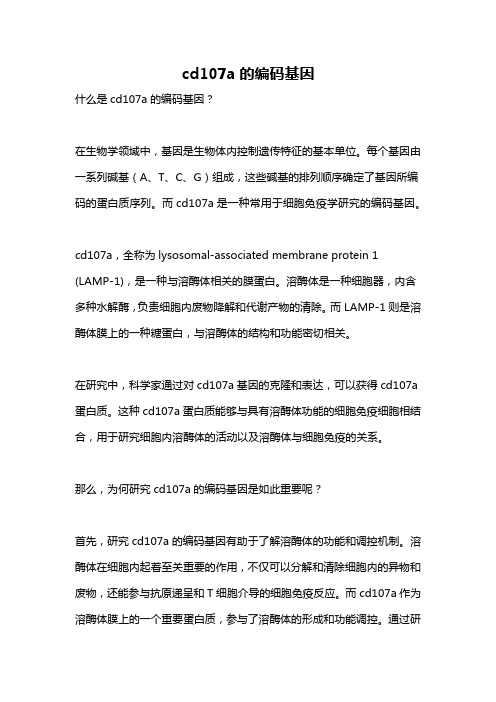
cd107a的编码基因什么是cd107a的编码基因?在生物学领域中,基因是生物体内控制遗传特征的基本单位。
每个基因由一系列碱基(A、T、C、G)组成,这些碱基的排列顺序确定了基因所编码的蛋白质序列。
而cd107a是一种常用于细胞免疫学研究的编码基因。
cd107a,全称为lysosomal-associated membrane protein 1 (LAMP-1),是一种与溶酶体相关的膜蛋白。
溶酶体是一种细胞器,内含多种水解酶,负责细胞内废物降解和代谢产物的清除。
而LAMP-1则是溶酶体膜上的一种糖蛋白,与溶酶体的结构和功能密切相关。
在研究中,科学家通过对cd107a基因的克隆和表达,可以获得cd107a 蛋白质。
这种cd107a蛋白质能够与具有溶酶体功能的细胞免疫细胞相结合,用于研究细胞内溶酶体的活动以及溶酶体与细胞免疫的关系。
那么,为何研究cd107a的编码基因是如此重要呢?首先,研究cd107a的编码基因有助于了解溶酶体的功能和调控机制。
溶酶体在细胞内起着至关重要的作用,不仅可以分解和清除细胞内的异物和废物,还能参与抗原递呈和T细胞介导的细胞免疫反应。
而cd107a作为溶酶体膜上的一个重要蛋白质,参与了溶酶体的形成和功能调控。
通过研究cd107a的编码基因,我们可以更好地理解溶酶体的结构和功能,进而探究细胞内的代谢和免疫反应机制。
其次,研究cd107a的编码基因有助于研究疾病的发生和治疗。
溶酶体功能的异常常常与各种疾病的发生和发展相关。
例如,溶酶体功能障碍可能导致溶酶体贮积病,溶酶体介导的细胞毒性对于抗肿瘤免疫有着重要作用。
研究cd107a的编码基因,可以帮助我们深入了解疾病发生的分子机制,从而开发出更有效的治疗策略。
然而,研究cd107a的编码基因也存在一定的挑战和困难。
首先,由于cd107a是一个膜蛋白,其结构复杂,因此在细胞内表达和纯化cd107a蛋白质十分困难。
研究人员需要使用一系列的分子生物学和蛋白质生化技术来克隆、表达和纯化cd107a蛋白质。
异硫氰酸荧光素 标记bsa 方法
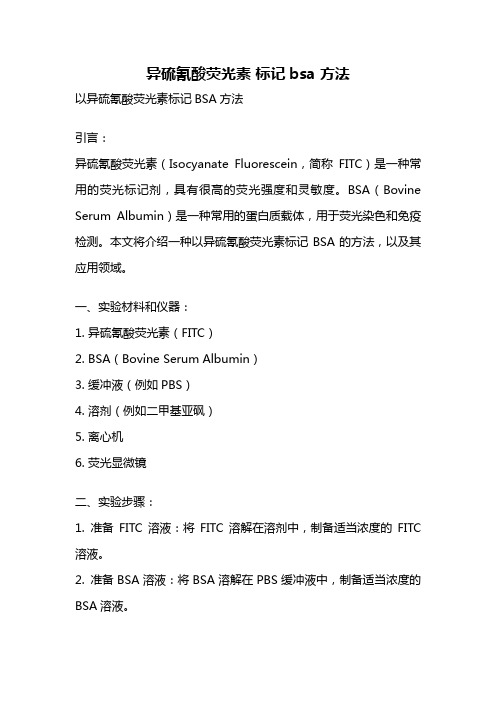
异硫氰酸荧光素标记bsa 方法以异硫氰酸荧光素标记BSA方法引言:异硫氰酸荧光素(Isocyanate Fluorescein,简称FITC)是一种常用的荧光标记剂,具有很高的荧光强度和灵敏度。
BSA(Bovine Serum Albumin)是一种常用的蛋白质载体,用于荧光染色和免疫检测。
本文将介绍一种以异硫氰酸荧光素标记BSA的方法,以及其应用领域。
一、实验材料和仪器:1. 异硫氰酸荧光素(FITC)2. BSA(Bovine Serum Albumin)3. 缓冲液(例如PBS)4. 溶剂(例如二甲基亚砜)5. 离心机6. 荧光显微镜二、实验步骤:1. 准备FITC溶液:将FITC溶解在溶剂中,制备适当浓度的FITC 溶液。
2. 准备BSA溶液:将BSA溶解在PBS缓冲液中,制备适当浓度的BSA溶液。
3. 添加FITC到BSA溶液中:将适量的FITC溶液滴加到BSA溶液中,充分混合。
4. 反应:将FITC和BSA在室温下反应一段时间,通常需要30分钟至1小时。
5. 停止反应:加入适量的抑制剂(例如甲醛)停止反应。
6. 离心:将反应液离心,以去除未反应的FITC和BSA。
7. 洗涤:用PBS缓冲液洗涤沉淀,以去除残留的FITC和抑制剂。
8. 重悬:将洗涤后的沉淀用PBS缓冲液重悬,得到标记好的BSA 溶液。
三、应用领域:1. 免疫荧光染色:标记了FITC的BSA可以用于细胞或组织的免疫荧光染色。
将标记好的BSA溶液加入样品中,充分混合后,使用荧光显微镜观察样品中的荧光信号,以获得目标分子的定位和分布信息。
2. 蛋白质检测:标记了FITC的BSA可以用于蛋白质的定量和检测。
将标记好的BSA溶液与待测蛋白质样品反应,通过测量荧光信号的强度来确定蛋白质的含量。
3. 免疫检测:标记了FITC的BSA可以用于免疫检测中的二抗。
将标记好的BSA溶液加入待检测样品中,充分混合后,通过荧光信号的强度来判断目标分子的存在与否。
美国国家标准ANSI/ASME B107.1—1993英制系列手用套筒扳手
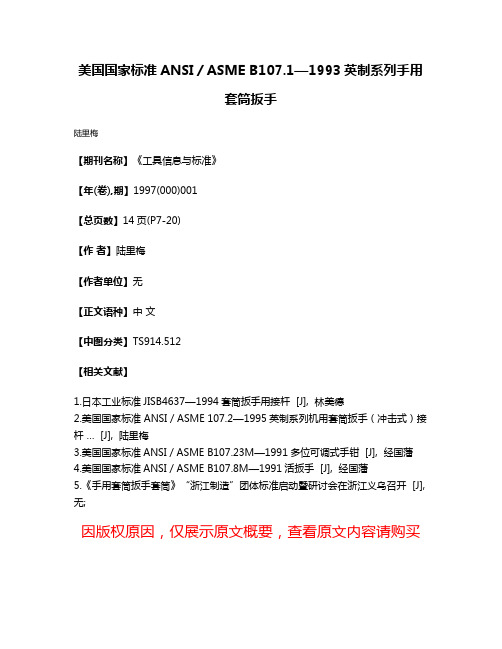
美国国家标准ANSI/ASME B107.1—1993英制系列手用
套筒扳手
陆里梅
【期刊名称】《工具信息与标准》
【年(卷),期】1997(000)001
【总页数】14页(P7-20)
【作者】陆里梅
【作者单位】无
【正文语种】中文
【中图分类】TS914.512
【相关文献】
1.日本工业标准JISB4637—1994套筒扳手用接杆 [J], 林美德
2.美国国家标准 ANSI/ASME 107.2—1995英制系列机用套筒扳手(冲击式)接杆… [J], 陆里梅
3.美国国家标准ANSI/ASME B107.23M—1991多位可调式手钳 [J], 经国藩
4.美国国家标准ANSI/ASME B107.8M—1991活扳手 [J], 经国藩
5.《手用套筒扳手套筒》“浙江制造”团体标准启动暨研讨会在浙江义乌召开 [J], 无;
因版权原因,仅展示原文概要,查看原文内容请购买。
台湾台化ABS ANC100物性数据表

ASTM D638/ISO 527
--
%
拉伸断裂伸长率(延伸率)
ASTM D638/ISO 527
--
%
弯曲模量(弯曲弹性率)
ASTM D790/ISO 178
25000(2450)
kg/cm²(MPa)[Lb/in2]
弯曲强度
ASTM D790/ISO 178
620(61)
ASTM D256/ISO 179
--
kg·cm/cm(J/M)ft·lb/in
23℃(无缺口)
ASTM D256/ISO 179
--
kg·cm/cm(J/M)ft·lb/in
-30℃(无缺口)
ASTM D256/ISO 179
--
kg·cm/cm(J/M)ft·lb/in
物性性能
比重(密度)
ASTM D792/ISO 1183
kg/cm²(MPa)[Lb/in2]
洛氏硬度
ASTM D785
R-101
IZOD缺口冲击强度
1/4" 23℃
ASTM D256/ISO 179
18(176)
kg·cm/cm(J/M)ft·lb/in
1/4" -30℃
ASTM D256/ISO 179
--
kg·cm/cm(J/M)ft·lb/in
1/8" 23℃
射嘴
-
℃
料筒前段
-
℃
料筒中段
-
℃
料筒段
-
℃
熔体温度
-
℃
模具温度
40~70
℃
压力
注塑压力
600~1100 Kg/cm2
AATCC107
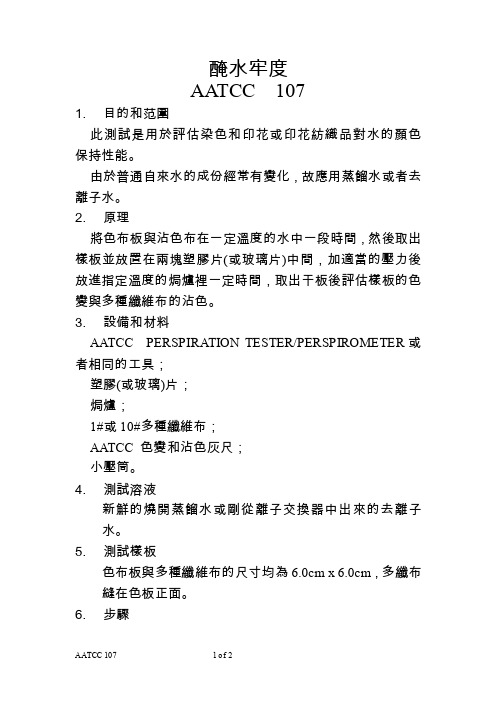
醃水牢度AA TCC1071.目的和范圍此測試是用於評估染色和印花或印花紡織品對水的顏色保持性能。
由於普通自來水的成份經常有變化,故應用蒸餾水或者去離子水。
2.原理將色布板與沾色布在一定溫度的水中一段時間,然後取出樣板並放置在兩塊塑膠片(或玻璃片)中間,加適當的壓力後放進指定溫度的焗爐裡一定時間,取出干板後評估樣板的色變與多種纖維布的沾色。
3.設備和材料AATCC PERSPIRATION TESTER/PERSPIROMETER或者相同的工具;塑膠(或玻璃)片;焗爐;1#或10#多種纖維布;AATCC 色變和沾色灰尺;小壓筒。
4.測試溶液新鮮的燒開蒸餾水或剛從離子交換器中出來的去離子水。
5.測試樣板色布板與多種纖維布的尺寸均為6.0cm x 6.0cm,多纖布縫在色板正面。
6.步驟將合成樣板泡在室溫蒸餾水或去離子中,不斷地攪拌直到完全濕潤,所需時間大約為15分鐘;取出樣板,將樣板放進小壓筒以去除多余的水,濕樣板的重量必須在2.5~3.0倍干樣板重量的范圍內;將樣板放在兩塊玻璃片或塑膠片(7.6cm x 6.4cm x 0.6cm)中間,然後放進汗漬測試器(PERSPIRATION),調節總壓力至4.5kg(即10LBS);將汗漬測試器放入焗爐,在38±1℃條件下存放18小時;取出樣板,室溫掛干,注意不能用熨燙法;7.色變評級方法用AATCC色變灰尺評定色布板的變色情況。
8.沾色評級方法用AATCC沾色灰尺評定多種纖維布的沾色情況。
9.准確度和偏差:略10.備注使用AATCC汗漬測試器時,無論樣板的數量多小,都須將所有的21塊玻璃片或塑膠片放入,當最後一塊放好後,將頂部壓板放上去,然後將3.6kg(即8LBS)的重量放上,以達至總重量4.5kg(即10LBS),鎖緊壓力後拿起重量。
注意將汗漬測試器放入焗爐時,壓力片和樣板要垂直(倒放)。
PERSPIROMETER:略泡樣板的方法可用另一種,將樣板不斷浸水,不斷遞入壓筒。
血清淀粉样蛋白A测定试剂盒(胶乳免疫比浊法)产品技术要求森美希克玛生物
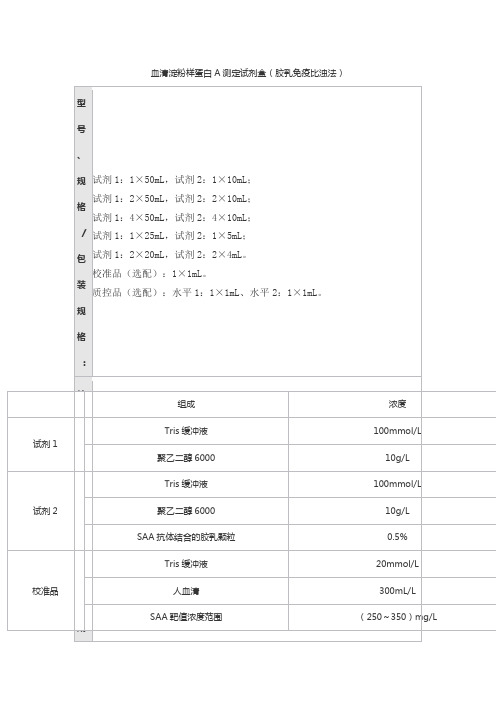
型
号
、
规 试剂 1:1×50mL,试剂 2:1×10mL; 试剂 1:2×50mL,试剂 2:2×10mL;
格
试剂 1:4×50mL,试剂 2:4×10mL; / 试剂 1:1×25mL,试剂 2:1×5mL; 包 试剂 1:2×20mL,试剂 2:2×4mL。
校准品(选配):1×1mL。 装 质控品(选配):水平 1:1×1mL、水平 2:1×1mL。
规
格
:
结
构
试剂 1 及
组
成 试剂 2
/
主
要 校准品
组
成
组成 Tris 缓冲液 聚乙二醇 6000 Tris 缓冲液 聚乙二醇 6000 SAA 抗体结合的胶乳颗粒 Tris 缓冲液
人血清 SAA 靶值浓度范围
浓度 100mmol/L
10g/L 100mmol/L
10g/L 0.5% 20mmol/L 300mL/L (250~350)mg/L
成
TriБайду номын сангаас 缓冲液
20mmol/L
分
质控品 :
人血清 SAA 靶值浓度范围
300mL/L 水平 1:(10~25)mg/L 水平 2:(75~120)mg/L
校准品靶值批特异,详见说明书。质控品质控范围批特异,详见说明书。
适 用 范 围
/
用于体外定量测定人血清中血清淀粉样蛋白 A 的含量。
预 期 用 途
:
产
品
储 2℃~8℃条件下避光保存,有效期为 18 个月。
存
条
件
及 有 效 期
( 体 外 诊 断 试 剂 适 用 ):
- 1、下载文档前请自行甄别文档内容的完整性,平台不提供额外的编辑、内容补充、找答案等附加服务。
- 2、"仅部分预览"的文档,不可在线预览部分如存在完整性等问题,可反馈申请退款(可完整预览的文档不适用该条件!)。
- 3、如文档侵犯您的权益,请联系客服反馈,我们会尽快为您处理(人工客服工作时间:9:00-18:30)。
Philips Semiconductors
Product specification
N-channel enhancement mode vertical D-MOS transistor
FEATURES • Direct interface to C-MOS, TTL, etc. • High-speed switching • No second breakdown DESCRIPTION N-channel enhancement mode vertical D-MOS transistor in TO-92 envelope and designed for use as line current interrupter in telephone sets and for application in relay, high-speed and line-transformer drivers. PINNING - TO-92 1 2 3 = = = source gate drain QUICK REFERENCE DATA Drain-source voltage Gate-source voltage (open drain) Drain current (DC) Total power dissipation up to Tcase = 25 °C Drain-source ON-resistance ID = 250 mA; VGS = 10 V Transfer admittance ID = 250 mA; VGS = 25 V Yfs RDS(on) VDS ± VGSO ID Ptot
Limiting values given are in accordance with the Absolute Maximum Rating System (IEC 134). Stress above one or more of the limiting values may cause permanent damage to the device. These are stress ratings only and operation of the device at these or at any other conditions above those given in the Characteristics sections of the specification is not implied. Exposure to limiting values for extended periods may affect device reliability. Application information Where application information is given, it is advisory and does not form part of the specification. LIFE SUPPORT APPLICATIONS These products are not designed for use in life support appliances, devices, or systems where malfunction of these products can reasonably be expected to result in personal injury. Philips customers using or selling these products for use in such applications do so at their own risk and agree to fully indemnify Philips for any damages resulting from such improper use or sale.
CHARACTERISTICS Tj = 25 °C unless otherwise specified Drain-source breakdown voltage ID = 10 µA; VGS = 0 Drain-source leakage current VDS = 130 V; VGS = 0 Gate-source leakage current VGS = 15 V; VDS = 0 Gate threshold voltage ID = 1 mA; VDS = VGS Drain-source ON-resistance ID = 250 mA; VGS = 10 V RDSon typ. max. typ. max. min. typ. VGS(th) min. max. IGSS max. IDSS max. V(BR)DSS min.
BS107A
max. max. max. max. typ. max.
200 V 20 V 250 mA 0.6 W 4.5 Ω 6.4 Ω 200 mS 350 mS
min. typ.
PIN CONFIGURATION
handbook, 2 columns handbook, halfpage
d
1
April 1995
6
Philips Semiconductors
Product specification
N-channel enhancement mode vertical D-MOS transistor
DEFINITIONS Data sheet status Objective specification Preliminary specification Product specification Limiting values
DISCRETE SEMICONDUCTORS
DATA SHEET
BS107A N-channel enhancement mode vertical D-MOS transistor
Product specification File under Discrete Semiconductors, SC13b April 1995
RATINGS Limiting values in accordance with the Absolute Maximum System (IEC 134) Drain-source voltage Gate-source voltage (open drain) Drain current (DC) Drain current (peak) Total power dissipation up to Tcase = 25 °C Storage temperature Junction temperature THERMAL RESISTANCE From junction to ambient (note 1) Note 1. Transistor mounted on printed circuit board, max. lead length 4 mm, mounting pad for collector lead min. 10 mm × 10 mm. Rth j-a = VDS ± VGSO ID IDM Ptot Tstg Tj max. max. max. max. max. max.
BScontains target or goal specifications for product development. This data sheet contains preliminary data; supplementary data may be published later. This data sheet contains final product specifications.
RDSon yfs
Ciss Coss Crss ton toff
typ. typ. typ. typ. typ.
45 pF 15 pF 3.5 pF 5 ns 15 ns
April 1995
4
Philips Semiconductors
Product specification
N-channel enhancement mode vertical D-MOS transistor
BS107A
200 V 20 V 250 mA 500 mA 0.6 W 150 °C
−55 to +150 °C
125 K/W
April 1995
3
Philips Semiconductors
Product specification
N-channel enhancement mode vertical D-MOS transistor
Note 1. Terminal dimensions within this zone are uncontrolled to allow for flow of plastic and terminal irregularities. OUTLINE VERSION SOT54 REFERENCES IEC JEDEC TO-92 EIAJ SC-43 EUROPEAN PROJECTION ISSUE DATE 97-02-28
BS107A
200 V 30 nA 10 nA 1.0 V 3.0 V 4.5 Ω 6.4 Ω 4.2 Ω 6.0 Ω 200 mS 350 mS
ID = 100 mA; VGS = 10 V Transfer admittance ID = 250 mA; VDS = 25 V Input capacitance at f = 1 MHz VDS = 25 V; VGS = 0 Output capacitance at f = 1 MHz VDS = 25 V; VGS = 0 Feedback capacitance at f = 1 MHz VDS = 25 V; VGS = 0 Switching times (see Figs 2 and 3) ID = 250 mA; VDD = 50 V; VGS = 0 to 10 V
